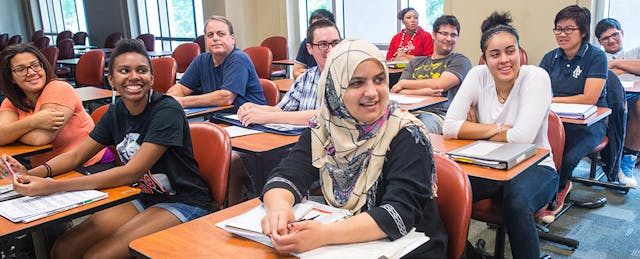Like all education ecosystems, community colleges have an array of different edtech tools to choose from. Where does one begin to search through the myriad of products out there—and find the ones best tailored to specific needs?
One suggestion: Listen to other community college educators, administrators and researchers, and learn about their recommendations. Over the past few months, EdSurge has spoken with a number of these constituents to find out what floats their boat; here’s what we learned.
Getting Students Organized and Keeping Them on Track
Take a look at the past few articles compiled by community college and higher education expert George Lorenzo, and a consistent theme arises in relation to the tools used by Hostos Community College in the South Bronx and Los Rios Community College in Sacramento. In both cases, administrators at each community college have endeavored to introduce technologies that offer students a way to communicate with advisors and stay on target.
At Hostos, creating its own tools with the aid of already-established platforms proved key. Specifically, the college created a myHostos mobile app where students can access information about financial aid, classes and the like. This came after experimenting with Succeed@Hostos, which Lorenzo describes as “an early warning system that enhances timely communication between students, professors and staff.” After reviewing a number of early-warning-system platforms, a Hostos committee ultimately chose the Starfish Early Alert and Connect solutions to serve as the backbone of Succeed@Hostos.
The word “success” seems to have been similarly reflected in Los Rios’ district-wide initiative called “Los Rios Steps to Success,” where the Sacramento college compiled a mix of five digital technologies and face-to-face components designed to support students in the likes of completing online orientation, completing and turning in assessments, and registering for classes.
Going the Distance for Special Needs and English Language Learners
With video conferencing and virtual education becoming more and more popular across the community college landscape, the question of how to best serve students with disability or language needs inevitably pops into conversation. The result? Professor Gina Sipley, Instructor of Reading and Basic Education at SUNY Nassau Community College in New York, says she and her fellow educators are often looking for closed captioning technologies.
“As professors begin to digitize their curriculum and develop videos for both face-to-face and distance education, these new resources need to be ADA compliant to meet the needs of students with IEPs and documented disabilities,” she says.
The benefits don’t stop there. “Developing captions and interactive transcripts, however, helps to improve outcomes for all students. We often serve students who negotiate a variety of literacy challenges (and some of these students might not be eligible for services that would directly specify accommodations),” Sipley says.
She identifies Adobe Spark and Kaltura as two tools that she has been impressed with, citing that Spark is useful for making brief ADA compliant videos while Kaltura offers the ability to build interactive transcripts and captioning.
This need for closed captioning is shared by other community college educators and administrators, including Jenny Quarles, Director of Teaching and Learning Technology for the Virginia Community College System (VCCS). She cites Panopto, a video content management platform, as her tool of choice for the 23 VCCS colleges she manages.
“Many of our institutions have been using a variety of lecture capture solutions over the years, but Panopto has really stood out as a partner for accommodating those with accessibility challenges,” Quarles says. “Our faculty are pleased with their captioning tool, and it has lifted a burden off of faculty who were previously making their own transcriptions or partnering with their college to pay for transcription services at a hefty cost.”
Overlapping Tools with K-12
Both Quarles and Sipley add a few tools to their favorites lists that might sound familiar to K-12 educators.
For Sipley, tools like Padlet, Google Apps for Education, and Remind allow her to best support students in her Bring Your Own Device courses. And for Quarles, VoiceThread is her go-to for creating interactive slideshow presentations: “Not only does VoiceThread make the traditional discussion board experience more engaging and interactive, but students also find it easy to use and appreciate the opportunity to be more creative and innovative when making their posts.”
But there’s one other thing that Quarles believes is crucial to community college success—and that’s taking students out of their physical spaces with augmented and virtual reality. In fact, at Southwest Virginia Community College, a team of faculty and instructional designers are already using augmented and virtual reality strategies for a crime scene technology class, where students can “can practice their crime scene investigation skills in ways that we cannot recreate in a physical space.”
Offering students a way to explore and learn is a hope shared by many a K-12 educator, and Quarles understands why: no educator wants to limit a student’s ability to learn, especially when it’s related to the limitations of a physical space.
“So many community colleges are place-bound, where students have not had the opportunity to explore the world. Whether using Google Cardboard or more advanced headsets, we are able to bring the world to the students,” she adds. “After this level of hands-on practice and exploration, students feel more prepared.”


